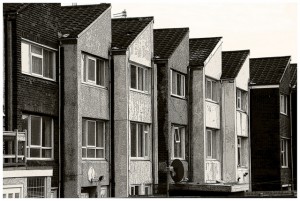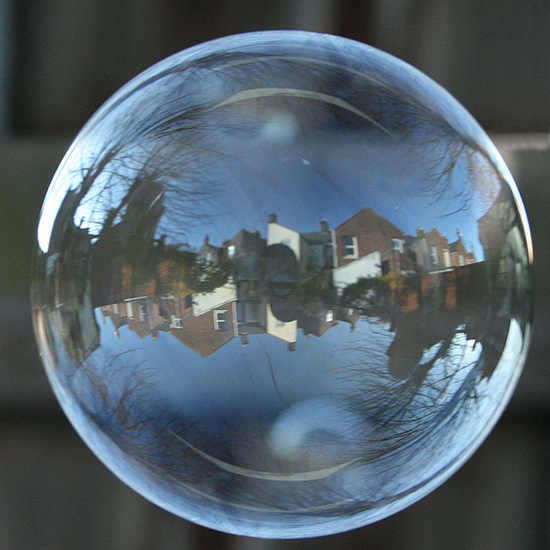A rise in Hispanic and Asian neighbors has changed the racial makeup of neighborhoods where the average black person lives, Margery Turner of think tank Urban Institute writes. Meanwhile, the percentage of white people in these neighborhoods hasn’t changed that much over the past 30 years, Turner notes. Take a look at these charts showing the racial breakdown of neighborhoods where the average black person lived in 1980 and today.
Continue reading
Around the City
Urban affairs, neighborhoods, subways and the people who are affected by them all.
RECENT POSTS
From Locksmiths To Luxury Condos: Businessman Talks 14th Street Evolution
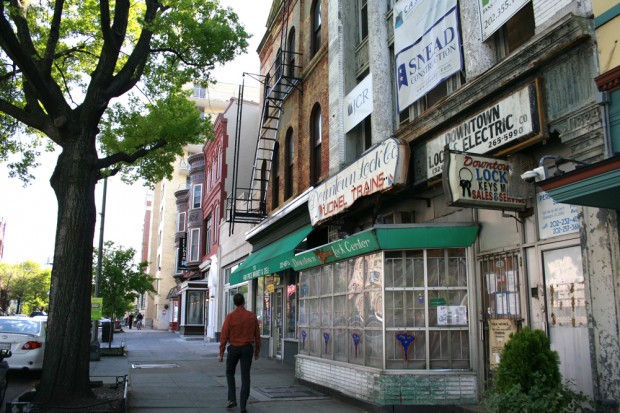
Elahe Izadi / DCentric
Downtown Lock Co. (center) has been on 14th Street since 1910. The building has been sold to make way for luxury condominiums along a street that's experiencing rapid redevelopment.
The evolution of 14th Street NW continues with regular announcements of new upscale restaurants and residences opening up along the corridor. But 14th Street wasn’t always the epicenter of fine dining in the District; in recent decades, it was more well-known as a place where drug dealers and prostitutes congregated.
A few older businesses still remain along the strip, but they’re starting to close shop, too. Take Downtown Lock Co. at 1345 14th St. NW, the building sold to make way for five, ultra-luxury condos.
“Back when we were there, the street had a lot of drugs, prostitution, a lot of drifters,” said Downtown Lock Co. co-owner Reuben Houchens. “You had to sort of establish yourself, first of all, that you weren’t afraid to be there. Of course we weren’t. [The way] we grew up, as we used to say, we knew the streets. And you had to basically hold your ground, as far as ‘we’re here and we will only tolerate so much.’ I’m talking about the pimps prostituting the girls, and drugs addicts and drug pushers — you had to be tough.”
In Your Words: Who Are The Native Washingtonians?
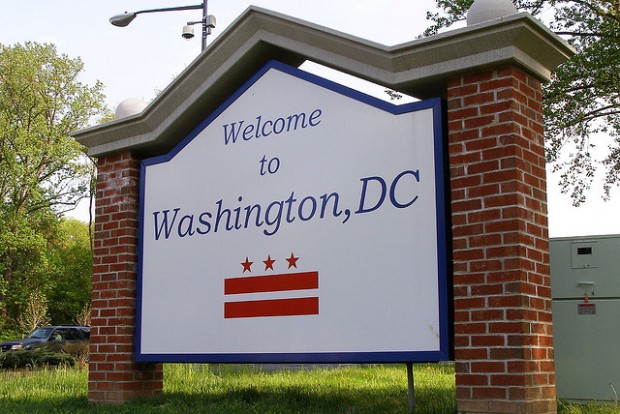
Mad African!: (Broken Sword) / Flickr
Most of D.C.’s newcomers hail from far-away locales rather than Washington’s suburbs, according to recent census estimates. Given that, I asked last week whether someone like me, raised in Maryland but now living in D.C., gets to claim any native Washingtonian status — a title that carries weight in this transient city. A number of you chimed in, both in our comments section and on Twitter. Continue reading
Who Can Claim ‘Native Washingtonian’ Status?
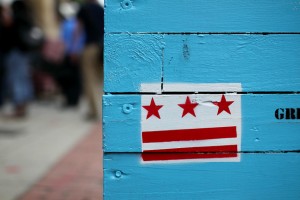
Mr. T in DC / Flickr
A D.C. flag painted on a planter on gentrified H Street NE.
Most newcomers to D.C. hail from from far-away places, not nearby suburbs, according to newly-released census estimates. More than double the number of people who moved into D.C. from Maryland and Virginia came from outside the region, such as New York and California.
While the nation has seen its population increase because of the rise of racial minorities, D.C.’s population has grown because of whites moving into the city. At the same time, the District’s black community has shrunk. And those leaving D.C. mostly move to places like Maryland’s Prince George’s and Montgomery counties, according to the census estimates.
All of these numbers makes me wonder about what it means to be a “native Washingtonian.” It’s a term that carries plenty of clout in this transient city, and especially in light of gentrification, it’s become code for “non-gentrifier.” But as the city swells with folks who hail from so far away, could local newcomers claim some of that clout, too? Take me, for example: I was born in D.C. and grew up in Maryland. I moved into the District a few years ago, but D.C. news, arts and politics have been a big part of my adult life. At the same time, I acknowledge that my childhood was marked more by rolling, rural hills than by city streets. Am I no different than someone who moved from, say, the Midwest?
Anyway, check out the full list of places from where D.C. newcomers hail and click through our map of movement throughout the D.C. region:
Gentrification And The Upper-Class Cultural Bubble
Author Charles Murray has been criticized and praised for his latest book, “Coming Apart,” in which he argues that white America is in crisis and that the country is divided primarily by class, not by race.
Murray’s argument is that “the super wealthy, super educated and super snobby live in so-called super-ZIP [codes]: cloistered together, with little to no exposure to American culture at large,” reports NewsHour. Murray’s book includes the “bubble quiz,” meant to determine just how out-of-touch respondents may be (and it’s presumably intended for whites).
A caveat to one of the questions may be of particular interest to our readers. The first question states, “Have you ever lived for at least a year in an American neighborhood in which the majority of your fifty nearest neighbors did not have college degrees?” But, the quiz qualifies, it doesn’t count if the neighborhood is gentrified and you’re one of the gentrifiers. In other words, Murray argues, gentrifiers are still in an upper-class bubble, even if they don’t technically live in one. Do you agree? It’s a salient question in D.C., given the number mixed-income neighborhoods.
And you can take the quiz here.
Gentrification’s Impact On Poor Children in Rich Neighborhoods
A reader adds to our discussion on whether poor children benefit by having rich neighbors. Soulshadow55 writes:
Yeah, that’s all well and good but what usually happens is that the neighborhood improves to the point that poor families can no longer afford to live in it. The increased tax base continues to attract so-called wealthy people to the neighborhood which decreases the number of poorer families with children. The new so-called wealthy people benefit more from all of the new facilities, the playgrounds, improved schools, better services, etc… [SIC]
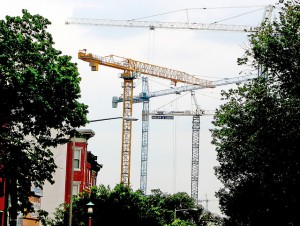
Harold Neal / Flickr
Gentrification is one of the main reasons behind why more poor District children now live in wealthier neighborhoods. Such neighborhood revitalization, which brings along amenities that children can benefit from, also increases property values. As a result, low- and moderate-income families renting at market rates may get priced out.
Those living in public housing, however, could be somewhat buffered by the negative impact of rapid gentrification, since rents remain steady. Take Columbia Heights, where public housing apartments are on the same block as million dollar homes. But good luck to anyone seeking public housing — the waiting for affordable housing vouchers in the District has swelled to more than 37,000-people long.
Poor Children, Rich Neighbors

Hawkins / Flickr
Columbia Heights is an economicaly diverse neighborhood, home to luxury high-rises and public housing.
Researchers have long noted the ills of growing up in a neighborhood of concentrated poverty — graduation rates are higher lower, access to healthy food is more limited and violence is more common.
“Neighborhoods of concentrated poverty are really hard on children,” said Gwen Rubenstein, deputy director of DC Action for Children, who ran the recent Kids Count report that found that concentrated poverty has dropped in D.C. She noted that children from upper and middle class families who live in high-poverty neighborhoods have an increased chance of being poor as adults.
But do poor children benefit if they live in neighborhoods of concentrated wealth? It’s a question that hasn’t been explored much in D.C. but one worth asking, given that the city’s childhood poverty remains high — one in three District children lives below the poverty line. At the same time, fewer kids live in neighborhoods of concentrated poverty now than a decade ago, but it’s not because their families are faring better. Rather, as more affluent people moved into neighborhoods that once had high poverty rates, more poor children are finding their neighborhoods transformed into wealthier places.
There’s a reluctance “to talk about concentrated privilege,” Rubenstein said. “Areas of concentrated privilege and poverty — we need to be talking about it and what it means for a community.”
DCentric Picks: Persian New Year Celebration

Lia / Flickr
A haft sin, or traditional table setting, was on display at last year's Freer and Sackler Galleries Now Ruz event.
What: Now Ruz, or a Persian New Year celebration
When: 11 a.m. to 5 p.m., Sunday
Where: Freer and Sackler Galleries at 1050 Independence SW.
Cost: Free, although some of the musical performances require free tickets. The food is available for purchase.
Why you should go: The annual event is held weeks before Now Ruz, or Persian New Year, an ancient festival. The museum will offer typical Persian New Year activities and attractions, including fire-jumping and traditional “haft sin” table displays, as well as classical and contemporary musical performances, photo booths and Persian food.
Finding Out About Group Homes and the Fate of the Peaceholics Buildings
The number of group homes in Ward 8 has been a point of contention among some residents in recent weeks. Such homes and shelters are actually called community residential facilities, and there are a number of reasons why group homes and transitional housing opens in Ward 8, including zoning, market forces and government-funding that has to be spent in low to moderate income communities.
Eleven D.C. agency representatives showed up to a Ward 8 community meeting last week to discuss the presence of community residential facilities in the area. Advisory Neighborhood Commissioner Sandra “S.S.” Seegars, who is running for the Ward 8 City Council seat, organized the meeting. And she, among other ANC commissioners, were vocal in their opposition to more homes opening in their communities.
Part of the ire from some local officials comes from the lack of notice they get when such facilities can open in their communities. In the past, Ward 7 Councilwoman Yvette Alexander proposed that ANCs to be notified when a group home was proposing to open. John Hall, director of D.C. Department of Housing and Community Development, which helps fund some community residential facilities, said moving forward ANCs would be notified when those submitting proposals for group homes don’t include a letter of support from the ANC. “I’m open to that,” Hall said. “With the next [request for proposals], we can do that.”
Not everyone opposes such group homes, such as ANC 8D02 Commissioner Olivia Anderson, who attended last week’s meeting.
“I came here to get information on group homes. As I’m sitting here, I’m hearing, ‘These children. These children.’ These children are our children, from our community and we need to welcome them back,” she said. “Not all these kids going to transitional housing are problematic kids.”
The most recent high-profile project includes a building at 1300 Congress Heights Street SE, spearheaded by nonprofit Peaceholics. The District government sunk $5.5 million into three vacant buildings that were intended to be fixed up and house “troubled” men between 18 and 24. The buildings could soon fall into foreclosure.
The borrower has until April to pay back the District. Hall said during last week’s Ward 8 community meeting that his agency is preparing to take over the buildings if the first lender can’t. If that happens, Hall said the Congress Heights building would become “quality affordable housing,” rather than community residential facility, as initially planned. He said the District has “gone down the group homes route with these projects before. I’d be a fool to go down that route again.”
Why Retirement is Tougher for Blacks, Latinos
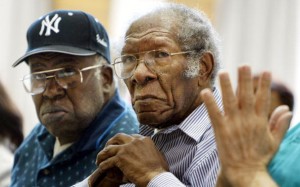
Mario Tama / Getty Images
Senior citizens attend a meeting with their senator about Social Security at the Isabella Geriatric Center in New York City. Black seniors, on average, rely more heavily on Social Security than whites.
Unemployment rates are higher for blacks and Latinos than for whites, but there’s another disparity at the end of the career spectrum: retirement. Black and Latino retirees have a tougher time financially than their white counterparts, according to a new University of California, Berkeley study [PDF]. Below are three reasons why:
Poverty is higher among black and Latino seniors than white seniors.
The poverty rate among all seniors is about 9 percent. For white seniors, it’s 7 percent, while for black and Latino seniors, it’s 19 percent. People of color over 60 years old are more likely to live in poverty because they rely on fewer sources of retirement income than white seniors, according to the study’s authors.



